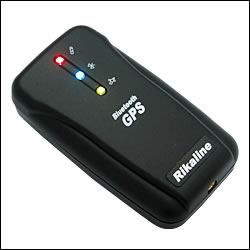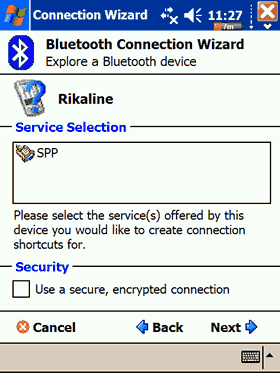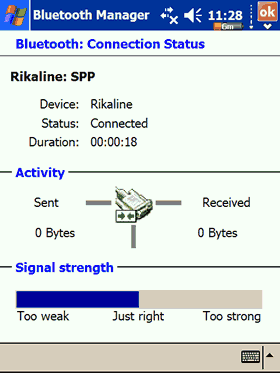1. Introduction
Rikaline, a well known GPS manufacturer, in their latest BT GPS receiver uses RFMD corporation's chipset, which is able to track up to 32 channels (satellites). Rikaline promises the quickest GPS TTFF from cold start, auto on/off function and of course, very good performance. We tested the Rikaline GPS-6033 comparing it to the BT-338 from Globalsat, a well known SiRF III enabled GPS device. First off, lets check out some background information on Rikaline the company.
- Rikaline background
 Rikaline International Corp. is a professional hi-tech products provider, focusing on GPS (Global Positioning System) and high value added PDA peripherals. Rikaline has invested and consolidated in related companies and technologies in the following 2 categories:
Rikaline International Corp. is a professional hi-tech products provider, focusing on GPS (Global Positioning System) and high value added PDA peripherals. Rikaline has invested and consolidated in related companies and technologies in the following 2 categories:
- GPS applications products such as CF GPS, GPS Receiver, GPS Module and personal navigation device.
- PDA peripherals: CF GPS, CF camera, CF GPRS, CF radio, CF VGA
Rikaline's goal is: "...Continuously providing people with easy and convenient living facilities. We hope everyone in the world shares our achievement and enjoy the life..."
- Rikaline GPS-6033
 The Rikaline GPS-6033 is a
total solution GPS receiver with Bluetooth wireless transmission ability, designed and based on next generation indoor GPS technology with super sensitivity at -157dBm (-187dBw) and low power (<80mA) consumption.
The Rikaline GPS-6033 is a
total solution GPS receiver with Bluetooth wireless transmission ability, designed and based on next generation indoor GPS technology with super sensitivity at -157dBm (-187dBw) and low power (<80mA) consumption.
This revolutionary system provides unbelievable positioning sensitivity, allowing you to have easy and quick position fix in urban canyon conditions.
You may use this device for strict requirements in positioning applications, such as car navigation, mapping, surveying, security, agriculture and so on.
 The GPS-6033 communicates with other electronic devices using the wireless Bluetooth technology. It can acquire 32 satellites in parallel when cold start, and displays the best 8 signals for power saving purposes.
The GPS-6033 communicates with other electronic devices using the wireless Bluetooth technology. It can acquire 32 satellites in parallel when cold start, and displays the best 8 signals for power saving purposes.
As Rikaline states, there are several other advantages of the GPS-6033: "...We built-in magnets inside the battery cover and include a set of round metal in the package for you to stick on anywhere suitable to GPS signal reception. Then you can place GPS-6033 on it. It will not move around in the car when you make sharp turn or sudden stop. If you need to bring it out, just use your fingers.
The world wide patented AUTO ON-OFF switch is the most important and useful feature of GPS-6033 when use it inside the car. Its function is controlled by the cigarette adapter. When you use it in a car and plug external power source to cigarette adapter, once you switch the engine on, GPS-6033 turns on automatically. Vise versa. When the car switch is off, GPS-6033 is off too. Therefore, you just need to find a place to put GPS-6033, then you do not need to care about anymore it in the future..."
- Used chipset
Rikaline GPS-6033 uses RFMD 8900 BT/GPS module, its full specs can be found below:

Comparing both chipsets, we can see that:
1. The RFMD doesn't support WAAS/Egnos, at least this is what Rikaline told us
2. The RFMD can track more channels in view (32 vs 20) compared with the SiRF III, but uses a maximum of 8
3. The RFMD has lower sensitivity (-157dBm) than the SiRF III (-159dBm)
4. The RFMD has lower acquisition times than the SiRF III
During our real-life tests, we will see how the RFMD chipset performs vs the SiRF III
2. Features
- Features
- Patent pending AUTO ON-OFF function makes you hands-free, once you place the device in place.
- Patent pending Easy-Place function makes the device steady, without sliding around the car.
- Wireless transmission positioning status up to 10 meters.
- High sensitivity receiver acquires 32 satellite signals in parallel, while providing first fast fix and low power consumption.
- Automatic baud rate setting, user does not need to do any selection.
- FLASH based program memory: New software revisions upgradable both for GPS and Bluetooth. (For distributor only).
- LED display status: The LED provides users with visible operating status for Recharging, Battery power level, Bluetooth and GPS. No extra devices needed.
- Rechargeable Li-ION battery provides long duration use.
For our testing purposes, Rikaline sent us the retail package that includes:
- GPS-6033 (Bluetooth GPS Receiver)
- a lithium-ION rechargeable battery
- a travel charger (110V/230V)
- a car cigarette adapter
- two easy-place pad
- a documentation CD
- warranty card
- a quick installation reference
The current price for the product is around US$85.95, as found around the net.

The contents of the retail package are showed below:

Looking at the device, on the front there are three LEDs which show device status. The Auto/on/off and power jack are located at the top.


On the bottom, we find the external antenna jack

Also on the bottom, we find the battery cover, which has a rubber surface to make the device stable when placed on the car dashboard:

The three LEDs are constantly lit when the device is operating. Other functions can be found in the following table:


Putting the Rikaline and its rival BT-338 side by side, we can see that the Rikaline is larger:



The included Li-Ion battery is rated at 3.7V with 1000mAh capacity.

Removing the battery cover we can find some info about the Rikaline GPS-6033:

3. Installation
Before you start using the device, you have to fully charge the battery. From our tests, it needs around 3 hours to fully charge.
It should fairly straightforward to connect to the Rikaline GPS with your PDA device, which in our case is a Dell Axim x50V with Windows Mobile 2003 SE. Start by accessing the Bluetooth manager and tap New->Connect.

The GPS-6033 will show up as Rikaline:

Press Next->Select GPS OUTPUT-> Next

Done!

After accessing the BT Manager, press right click->Connect

Finally, the device was connected to our Dell Axim x50V PDA and ready for use!

The device can be found at COM7 with 4800 communications speed. Press the "Scan GPS" and if all goes well, you will see a lot of numbers scrolling down.

Unfortunately, all currently available software doesn't support the RFMD chipsets, therefore you cannot set any special settings (WASS, Static navigation). With GPSInfo, we were able to catch some reported info, which is probably the device's firmware revision (2.6.5):

4. The Tests
- Tests Day One
We tested the Rikaline GPS-6033 with a Dell Axim X50v. We recorded all produced data for a pre-selected route with VisualGPSce (free edition) and later analyzed it with GPSLog. We couldn't measure the TTFF ("Time to First Fix" which is the time it takes for a GPS to determine its current position), since GPSInfo "Cold Start" function doesn't work with RFMD chipsets. All tests ran continuously, under the same environmental conditions (night, clear sky, 2.5° Celsius ) and installed in an Audi, model A4 2004.
| |
Globalsat BT-338
|
Rikaline GPS-6033 |
|
Time to First Fix (TTFF) |
Secs |
38 sec |
? |
|
Fix |
Invalid |
0 |
0 |
| 2D |
0 |
3.7 |
| 3D |
100 |
96.3 |
|
Satellites |
Average (in view) |
8 |
8 |
| Average (in use) |
5.19 |
4.62 |
|
Average Signal Level (in dB) |
Maximum per Satellite |
47.33 |
51.00 |
| Average per Satellite |
38.43 |
41.80 |
The Rikaline GPS-6033 produced very good performance in this test. While we couldn't test the TTFF times, we didn't have problems with it. The Average Signal levels are high, reaching up to 51dB, while the average signal level was up to 41.80dB. On the other hand, while the device constantly tracks 8 satellites, it used only 4.62 on average. Lastly, its 3D fix was not a perfect 100%, as it was with the BT-338.
- Tests Day Two (Pedestrian use)
We tested the device with a Dell Axim X50v. We recorded all produced data for a pre-selected route with VisualGPSce (free edition) and later analyzed it with GPSLog. All tests ran continuously, under the same environmental conditions (day time, clear sky, 20° Celsius ) carried along with us as we walked about. For this test, we enabled the "Static Navigation" for GlobalSat BT-338. There is no such function available for the Rikaline GPS-6033.
| |
Globalsat BT-338 |
Rikaline GPS-6033 |
|
Fix |
Invalid |
0 |
0 |
|
2D |
0 |
0 |
3D
|
100 |
100 |
|
Satellites |
Average (in view) |
8 |
8 |
|
Average (in use) |
5 |
6.64 |
|
Average Signal Level (in dB) |
Maximum per Satellite |
45.00 |
43.00 |
|
Average per Satellite |
35.73 |
31.11 |
| Speed (km/h) |
Minimum |
1.06 |
1.58 |
| Maximum |
6.23 |
10.23 |
The Rikaline GPS-6033 doesn't have any option (via software), to turn on or off static navigation. The reception levels were acceptable but after analyzing the logs, we saw that there are some issues, since the GPS-6033 didn't always report speed (km/h) whereas the BT-338 did.
- Tests Day Three (External Antenna)
We tested the device with a Dell Axim X50v. We recorded all produced data for a pre-selected route with VisualGPSce (free edition) and later analyzed it with GPSLog. All tests ran continuously, under the same environmental conditions (night, clear sky, 2.5° Celsius ) and installed in an Audi, model A4 2004. This time, we installed an external antenna to the device to see if it would make any difference.
| |
Rikaline GPS-6033 |
Rikaline GPS-6033 + antenna |
|
Fix |
Invalid |
0 |
0 |
|
2D |
3.7 |
0.7 |
3D
|
96.3 |
99.3 |
|
Satellites |
Average (in view) |
8 |
8 |
|
Average (in use) |
4.62 |
5.76 |
|
Average Signal Level (in dB) |
Maximum per Satellite |
51.00 |
51.00 |
|
Average per Satellite |
41.80 |
39.05 |
The external antenna improved the 3D Fix % and more satellites (average) were in use. The maximum level per satellite was the same, however the average signal level per satellite was somewhat lower than without the antenna.
- - Tests Day Four ( Indoor Sensitivity)
We placed both receivers inside a house, close to a big window and observed their performance. The Rikaline GPS-6033 had a 3D fix, with 8 satellites in view and 5 in use, whereas the Globalsat BT-338 also had a 3D fix but with 7 satellites in view and 5 in use.
- Overall impressions
The Rikaline GPS-6033 had very good performance with almost all tests. Despite the fact that we couldn't measure its TTFF, it appeared to be short, probably due to the device's ability to receive up to 32 channels. The device is not ideal for pedestrian use, compared with BT-338. Overall, the GPS-6033 had very good reception levels, 8 satellites in view (always) and an average of 5 in use. The option for connecting an external antenna further boosts the device.
5. Conclusion
The Rikaline GPS-6033 is based on the RFMD 8900 GPS chipset, promising high reception levels and very low TTFF times. The built-in battery lasts up to 10hours and is rated at 1000mAh. The use of the external antenna further boost reception levels. Overall performance was very good, offering the highest maximum reception level we have seen (51dB) and while the specs state 32 satellites in view, only 8 are used at a time. Its retail price is around US$85.95 making it a good alternative to the Globalsat BT-338 (US$120).

The Positive
- Complete retail package
- Auto on/off power save function
- Car charger is included
- Special pads are included for using in a car
- Very good performance
- Easy installation (includes a well written printed manual)
- External antenna offers better performance (optional cable)
- Good performance indoors
- Small dimensions and low weight make it portable
The Negative
- Not ideal for pedestrian use (walking)
- Doesn't support WAAS/Egnos (?)
- Included battery lasts only 10 hours (according to the specs)